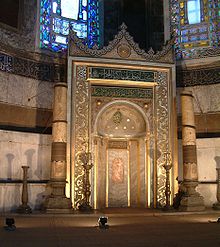Hagia Sophia- Architectural Features
The Hagia Sophia is one of the most interesting and mysterious buildings left from the ancient world. It’s enormous size and ability to withstand 1500 years of earthquakes is under investigation. The building reached completion in the year 537. The ceiling stands 180 feet high by 100 feet across. The core structure of the building is the enormous main dome supported by four arches. On each end, their are two semi-domes backed by four giant pillars. It’s main architectural features include the nave, exedra, narthex, apse, and parapets. A nave is an enormous main room; in the Hagia Sophia, this is the area beneath the largest dome, with smaller domes above. The exedra is a semicircular room with benches; its purpose could be worship or conversation. There are exedras built off of the east and west domes in this structure. The narthex is located at the entrance; this is reserved for an emperor, and has a long ramp that leads to the upper gallery. A Byzantine mosaic of Christ and an unknown emperor is above the narthex. The apse is a large recess at the east end; it is reserved for an altar. Above the apse is a magnificent mosaic of the Virgin Mary. Finally, the Hagia Sophia contains marble parapets that make up the ledges; they are up to 60 centimeters thick. The interior contains polychrome marbles, green, white, and purple porphyry, and nearly four acres worth of gold mosaics.
Sources:
https://en.wikipedia.org/wiki/Hagia_Sophia#Apse_mosaics
https://en.wikiarquitectura.com/index.php/Hagia_Sophia#Alzado
 The layout of the Hagia Sophia.
The layout of the Hagia Sophia.
 The mihrab in the apse.
The mihrab in the apse.
 The tall ceiling of the nave.
The tall ceiling of the nave.
Hagia Sophia
The Hagia Sophia is a large place of worship. This place was full of religious items that surrounded a giant wall called an iconostasis. An Iconostasis is described as a wall of religious icons, separating the nave (the main body of the church) from the sanctuary. The relics are usually made up of tombs or tangible items that show how the person was alive. Relics important in every religion including Christianity, Hinduism, ect. Catholic’s however don’t worship any sacred relics, they practice that the only thing/person to be worshiped is God. When this first began, no one could varify if the relics were authentic or not, so many fraudulent relics began to appear. After this became a little out-of-hand, the church decided to “authenticate” the relics as they came. The Hagia has since displayed some amazing artifacts, including the nails from the crucifixion of Jesus Christ.

- « Previous Page
- 1
- …
- 55
- 56
- 57
- 58
- 59
- …
- 94
- Next Page »
